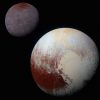Secrets behind Pluto’s dunes revealed0
- From Around the Web, Space
- June 2, 2018
Scientists have discovered dunes on Pluto, and say they are likely to have been formed of methane ice grains released into its rarefied atmosphere.

Scientists have discovered dunes on Pluto, and say they are likely to have been formed of methane ice grains released into its rarefied atmosphere.

The dwarf planet was reclassified once before in 2006.

Once held to be the outermost planet of the Solar System, Pluto‘s designation was changed by the International Astronomical Union in 2006, owing to the discovery of many new Kuiper Belt Objects that were comparable in size. In spite of this, Pluto remains a source of fascination and a focal point of much scientific interest. And even after the historic flyby conducted by the New Horizons probe in July of 2015, many mysteries remain.

Pluto has long been viewed as a distant, cold and mostly dead world, but the first spacecraft to pass by it last year revealed many surprises about this distant dwarf planet.

Something very odd is going on around Pluto.

NASA’s New Horizons space probe has been busy the past few years. After traveling roughly 4.67 billion miles to reach the dwarf planet Pluto’s system in July of 2015, the spacecraft is now moving on to its next target, an object discovered in the Kuiper Belt by the Hubble Space Telescope in June of 2014 and dubbed 2014 MU69.

Pluto is thought to possess a subsurface ocean, which is not so much a sign of water as it is a tremendous clue that other dwarf planets in deep space also may contain similarly exotic oceans, naturally leading to the question of life, said one co-investigator with NASA’s New Horizon mission to Pluto and the Kuiper Belt.

Despite wrong conditions, handful-plus of photons detected streaming from dwarf planet

Ever since NASA’s New Horizons spacecraft flew by Pluto last year, evidence has been mounting that the dwarf planet may have a liquid ocean beneath its icy shell.

The New Horizons probe has uncovered another Plutonian mystery – this time involving the solar wind.



